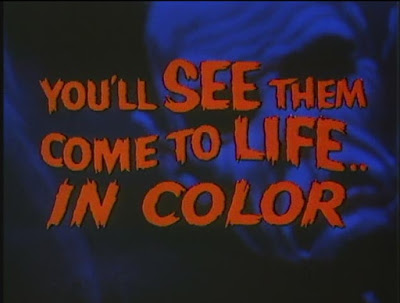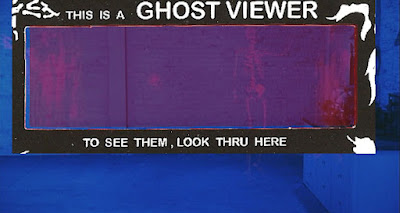
Seeing "Night of the Living Dead" (1968, George Romero) was a rite of passage for me. Every year, around Halloween, it would play on late night television, and every year my parents would have a little discussion over whether I was old enough to see it or not. The Halloween that I was 11-years old, they decided I was finally old enough to stay up (midnight!) to watch it. It instantly became one of my favorite horror films and still is today.
I have no idea how well the film has aged, because every time I go back to re-watch it, I am 11-years old again. I buy into it absolutely, every time. The tension, the claustrophobia, the feeling that the world is coming apart and there's nothing you can do to stop it...that all the rules that hold society together are being incrementally broken and rendered irrelevant by the worst kind of monster.
As I got older, and began reading books about film, I became aware of the cultural subtext that elevated this little low-budget zombie film to a cultural touchstone. "Night of the Living Dead" has been described as an allegory for everything from the Vietnam war to the civil rights movement, from class warfare and capitalism to government impotence and the hippy culture. These interpretations are all highly subjective, but interesting.
The main conflict is of course between the suddenly reanimated dead who are mindlessly clawing towards the nearest living thing in search of food, and the seven people that have fled to an abandoned farmhouse in hopes of survival.
But a side conflict erupts among our protagonists. Should they stay on the ground floor of the house, where the many windows and doors serve as avenues for escape, but also as potential points of entry for the zombies, or should they all bunker down in the cellar, which has only one very strong door, but no other exits?
"The cellar is a death trap!" -Ben

On one side is Ben. Ben comes off as intelligent, resourceful, organized, level-headed. When he first arrives at the house, he fights off the few zombies that have found their way in, then sets about tirelessly boarding up the windows and doors himself. He finds a shotgun, and a pair of shoes for Barbra, who is rendered useless by shock. When he declares the house safe, we believe him.
In writings on "Night..." much has been made of the fact that Ben is black. In 1968 it was unheard of to have an African-American leading man among a cast of whites, especially without any attention being paid to it in the course of the plot. In fact, Ben's race doesn't seem to factor at all--none of the other characters make any reference to it, direct or implied.
Director Romero, from what I've read, did not deliberately write the part of Ben for a black actor, and only cast Duane Jones for the part because he gave the best read. This hasn't stopped some critics and fans from reading a commentary on race relations into the film.
The windows and doors boarded up, Ben is the one who tries to organize an escape plan. He wants to get out of the house as soon as possible and get to the nearest rescue station.
"That's the cellar. It's the safest place." -Harry Cooper

On the other side is Harry Cooper. Harry has been secretly boarded up in the cellar the entire time with his wife Helen, their daughter, and friends Tom and Judy. He makes his presence known about halfway through the film, and is almost immediately unlikeable. Chain-smoking, shifting and tense, barking orders at his wife and everyone else, Harry is the last person you want to be trapped in a house with.
The actor that plays Harry (Karl Hardman) is about 10 years older than Duane Jones, and his character does seem to represent an out-of-touch, older generation. When he challenges the safety of the boarded-up house, it seems more a result of his own narrow-mindedness than a legitimate concern. He rejects Ben’s plan to go for the rescue station...he wants to wait the night out in the cellar, where there's only one door to protect.
The argument between Ben and Harry begins almost immediately and never lets up, in a series of escalating exchanges:

"I'm telling you they can't get in here. You lock yourself in the cellar and those things get in here, you've had it. At least up here you have a fighting chance." -Ben
...

"Those things are going to be at every window and door in this place! We've got to get down to the cellar!" -Harry
...

"If you’re stupid enough to go die in that trap, that’s your business. However, I am not stupid enough to follow you." -Ben
In these exchanges, Ben always comes across as trustworthy, proactive and practical, Harry as cowardly and stubborn. Slowly, Ben wins over every one else in the house to his plan, except for damned pigheaded Harry.You find yourself rooting for Ben against Harry, even after a boarded window is breached.

It doesn't take long before it is clear that the first window breach was no fluke. Harry was right. The windows and doors aren't sufficiently reinforced, and they begin to come apart, one by one.

Helen falls to the ghouls.

And then Barbra is taken.

Overrun, Ben is forced to retreat to the cellar.


Although I had seen the film countless times, it never occurred to me that Ben’s final flight to the cellar represented anything more than the random course the night’s adventure had taken. It was only when I got older that it hit me how absolutely wrong Ben had been....the windows and doors weren’t strong enough, his insistence on staying upstairs had cost the lives of everyone else in the house, and I had been rooting for him, against Harry, the entire time on the basis of personality and likability.
When I finally had this revelation, I perceived a guilty resignation in Ben’s face once he’d fled to the cellar, that I had not seen before.

Ironically, the cellar door is only secure because Harry and Tom had reinforced it. "Tom and I fixed it so it locks and boards from the inside." Harry had told Ben earlier.

Harry at this point is a zombie in the cellar, and Ben is now faced with having to shoot him to secure his own survival in the very cellar he declared a "death trap". Ben now rides the night out, the lone survivor, in the safety of the cellar, protected with a door Harry reinforced.

As morning comes, Ben is awakened by the sound of gunshots. A posse has arrived and is shooting zombies on sight.

As Ben approaches the window to look, he aims his shotgun out the window.

I previously never assigned any importance to Ben’s decision to raise his gun while approaching the window, but now I wonder if this was a suicidal gesture, born of guilt? None of the zombies so far has shown any intelligence other than the very crude use of rocks and sticks to break things. Ben must have known it was living humans, not zombies, shooting those guns. So why does he approach the window in such a hostile stance?

"Night of the Living Dead" has been reissued, remade and re-released so many times (Amazon returns 126 entries as of this writing) it can be difficult to sift through when trying to buy a copy. I recommend
Elite Entertainment's Special Collector's Edition. It is the original 1968 version with beautifully restored image, and includes commentary tracks, interviews, and extras.



 Frankenstein...
Frankenstein... Vampire...
Vampire... Ghost...
Ghost... Here's the inside without the stickers sheets.
Here's the inside without the stickers sheets.















































